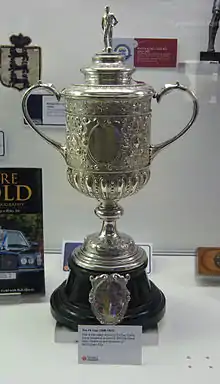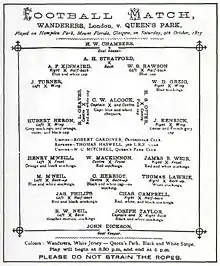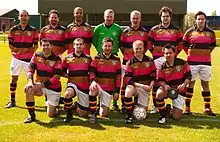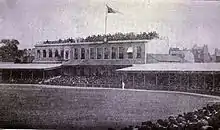Wanderers F.C.
Wanderers Football Club is an English football club based in Upper Norwood, London. The original club was an amateur one founded as "Forest Football Club" in 1859. In 1864, it changed its name to "Wanderers". Comprising mainly former pupils of the leading English public schools, Wanderers was among the dominant teams of the early years of organised football and won the Football Association Challenge Cup (known in the modern era as the FA Cup) on five occasions, including defeating Royal Engineers in the first FA Cup final in 1872.
 | ||
| Full name | Wanderers Football Club | |
|---|---|---|
| Nickname(s) | Rovers | |
| Founded | 1859 (as Forest F.C.) | |
| Dissolved | 1887 (reformed in 2009) | |
| Ground | Prince George Playing Fields | |
| Chairman | Jamie Harvey | |
| Manager | Joe Poxon | |
| League | Surrey South Eastern Combination Junior Division One | |
| Website | Club website | |
|
| ||
The club played only friendly matches until the advent of the FA Cup in 1871, with the rules often differing from match to match as various sets of rules were in use at the time. Even after the formation of The Football Association (the FA) in 1863, of which the club was among the founder members, Wanderers continued to play matches under other rules, but became one of the strongest teams playing by FA rules. They won the FA Cup three times in succession during the late 1870s, a feat which has only been repeated once. Among the players who represented the club were C. W. Alcock, the so-called "father of modern sport", and Arthur Kinnaird, regarded as the greatest player of his day. The club took its name from never having a home stadium of its own but playing at various locations in London and the surrounding area. By the 1880s the club's fortunes had declined and it was reduced to playing only an annual match against Harrow School, the alma mater of many of its founders.
The new club was formed in 2009 to continue the name Wanderers, reportedly with the endorsement of the descendants of the Alcock family, for the purposes of fundraising for UNICEF UK.[1] Since 2011, the revived club has competed in the Surrey South Eastern Combination.
History
Early years (1859–1871)
.jpg.webp)
The club was initially formed as Forest Football Club in 1859 by a number of former public school pupils, primarily recent Old Harrovian school leavers who wanted to continue to play the sport[2][3] Founder members included Charles W. Alcock, who had just left Harrow School, his brother John F. Alcock, J. Pardoe and brothers A. and W. J. Thompson.[4] Several Old Foresters also played for the Forest club, as Forest School was located less than a mile north of the ground.[5]
For the first two years of the club's existence, the players organised matches among themselves at Snaresbrook near Epping Forest, probably on a part of Epping Forest between the Infant Orphan Asylum and Forest Place.[5][6] Forest's first match against another club took place on 15 March 1862, and resulted in a victory over Crystal Palace (not the modern club of the same name).[7] Both this match, and a return fixture between the two teams the following month, involved fifteen players on each team.[8] At the time, the rules of association football had not been codified, and many variants existed, differing in the number of players per team, whether players were permitted to play the ball with their hands, or the method of scoring goals. The club's rulebook from 1861 was based on the Cambridge rules of 1856 with a small number of additions.[9][10] In a September 1862 newspaper advertisement, the club sought opponents for matches "on the rules of the University of Cambridge".[11]

In 1863 the Forest club was among the founder members of The Football Association (the FA) and adopted the rules set down by that body, although they continued to play occasional matches under other sets of rules against clubs not affiliated to the FA.[12]
| Wikisource has original text related to this article: |
The following year, the club played its first match under the name Wanderers Football Club, against N.N. Club of Kilburn.[13] Alcock had decided, possibly because of the expense the club was incurring by owning its own ground, to turn it into a "wandering" team with no fixed home venue, however it appears that some of the club's members opposed this idea.[14] For the following season teams operated under both names, with several players appearing for both, and indeed Forest and Wanderers even played each other in one match, but after 1865 there is no record of any further matches under the Forest name.[15] The Wanderers initially fared well, losing only one of their sixteen matches in the 1865–66 season, but over the subsequent four seasons the team's fortunes declined significantly and Alcock also found it increasingly difficult to ensure that eleven of his players actually turned up for a match, with the club often forced to play with fewer than the required number of players or borrow some from their opponents.[16] During this period the club played a number of "home" matches at Battersea Park and Middlesex County Cricket Club's Lillie Bridge Grounds.[17] Wanderers subsequently made Kennington Oval its semi-permanent home in 1869.[18] The club played 151 matches at The Oval.
Cup success (1872–1878)

In the 1870–71 season, the Wanderers finally turned around their fortunes, losing only five of thirty-seven matches played.[19] For the following season the FA, following a suggestion by Alcock, initiated the Football Association Challenge Cup, a knock-out tournament open to all member clubs. Due to a combination of their opponents withdrawing and an unusual rule in place at the time which allowed both clubs to progress to the next round in the event of a draw, Wanderers only won one game in the four rounds leading up to the final, held at the Kennington Oval on 16 March 1872. The club beat the Royal Engineers 1–0 to become the first ever winners of the cup, the winning goal being scored by Morton Betts, who was playing under the pseudonym "A. H. Chequer".[20]

The following season, under the competition's original rules, Wanderers, as holders, received a bye all the way to the final. In the final Wanderers beat Oxford University 2–0 to retain the cup, thanks in large part to the performance of A. F. Kinnaird.[21] The club was unable to replicate this success over the next two seasons, although the team did manage a club record 16–0 victory over Farningham in the first round of the 1874–75 FA Cup.[22]
In October 1875, Wanderers travelled to Scotland for the first time, to play a match against the leading team from north of the border, Queen's Park. Despite fielding their strongest team, Wanderers were outclassed by the Scots and lost 5–0. The London club gained its revenge four months later, however, when Queen's Park travelled to London for a re-match and lost 2–0. This was the first match the Glasgow club, which had been formed nine years earlier, had ever lost.[23] Wanderers reached the semi-finals of the FA Cup without conceding a goal and then defeated Swifts to set up a final against Old Etonians. The Etonians' team contained five former Wanderers players, including Kinnaird.[24] After the initial match finished in a 1–1 draw, Wanderers won the replay 3–0 to win the tournament for the third time.
The following season, with Kinnaird back in the team, Wanderers overcame indifferent early form to again reach the Cup final, and defeated Oxford University to retain the trophy. Wanderers again dominated the competition in the 1877–78 season, scoring nine goals in both their first and second round matches. The final was a rematch of the 1872 final and Wanderers again defeated Royal Engineers to win an unprecedented third consecutive FA Cup. The rules of the competition stated that under such circumstances the trophy would be retired and become the permanent property of the victorious club, but Alcock returned the cup to the FA on the condition that the rule be removed and no other team permitted to claim it on a permanent basis. Following the final, Wanderers played the reigning Scottish Cup holders, Vale of Leven, but lost 3–1.[25]
Decline (1879–1887)
The Wanderers' fortunes declined rapidly following the club's hat-trick of FA Cup wins. By 1878, football clubs had been set up for former pupils of all the leading public schools, and many leading players chose to play for their respective old boys' team instead. Wanderers' fixture list was dramatically reduced in the 1878–79 season, and the team was knocked out of the FA Cup in the first round, losing 7–2 to an Old Etonians team led by Kinnaird.[26] The following season Wanderers managed to reach the third round of the Cup, but lost again to the Etonians, after which many more key players left the club.[27]
The club struggled on into the 1880–81 season, but was forced to withdraw from the FA Cup after being unable to raise a team for the scheduled first round match. After 1881, the club was reduced to playing only one match per year, against Harrow School each Christmas.[28] A book published by the newspaper The Sportsman claimed that the club folded in 1884,[29] however a match at Harrow was reported in The Times in December 1887, which Harrow won 3–1.[30]
Legacy and revival

In 2009, over 120 years after the last known Wanderers match, a "reformed" Wanderers club was founded in London, reportedly with the approval of descendants of those involved with the original club, with the intention to play occasional matches for charity.[31][32] In 2011 the club joined the Surrey South Eastern Combination. On 7 November 2012, the team played the Royal Engineers at The Oval in a rematch of the 1872 FA Cup Final, 140 years after the original event.[33]
Wanderers gained promotion from the Combination's Junior Division 4 in 2013,[34] after finishing as runners-up. In 2014 they achieved a second consecutive promotion after being crowned champions of the Junior Division 3.[35] The following season they managed their third promotion as they progressed to Junior Division 1.
In 2018 the club ran a successful crowd funding campaign in order to raise over £10,000 for the regeneration and development of the playing field of Virgo Fidelis Convent School. The redeveloped land will be used by both the school and as the club's permanent home ground from the beginning of the 2019 season.[36]
Colours and crest
Wanderers are known to have played in orange, purple, and black for at least part of their existence, although as no photographs of the team exist, the exact design is not known. A replica shirt sold in the modern era has the three colours in horizontal stripes,[37] a likely arrangement given that horizontally-striped shirts were very common during the Victorian era.[38] The programme for the club's 1875 away match with Queen's Park, however, lists Wanderers as playing in white shirts. In the absence of shirt numbering, which would not be introduced for another sixty years, the programme identifies the individual players by the colours of their stockings (socks) or caps, with Alcock and Kinnaird both listed as wearing blue and white caps and Jarvis Kenrick identified by his cerise and French grey cap, the colours of his former club Clapham Rovers.[23] The modern club's crest is derived from the Harrow School crest, which may have adorned the shirts of the original team.[39]
1859: Forest FC[40] |
1872–78[41] |
1875 match v. Queen's Park |
2009[42] |
2016-18 |
Grounds

Wanderers played firstly at Snaresbrook near Epping Forest, reputedly close to one of two orphanages in the area; the Infant Orphan Asylum in Snaresbrook or the Merchant Seaman's Orphan Asylum in nearby Wanstead.[5] When the Forest club briefly reformed in 1868, it was reported that they played on the old ground in front of Forest Place.[6] Therefore it is probable that their ground was located at Leyton Flats in Epping Forest, between The Infant Orphan Asylum (now Snaresbrook Crown Court) and Forest Place (now Whipps Cross Road). Wanderers played at several locations between 1859 and 1887 throughout London, but predominantly at Kennington Oval (151 games), Vincent Square (31), Harrow (23), Harrow School (15) and Clapham Common (12).[43] Battersea Park has been erroneously attributed as Wanderers home ground,[44] however Wanderers played just 10 games there between 1864 and 1867.[43]
Rivalries
Prior to the formation of The Football Association in 1863, individual schools played football according to their own particular rules.[45] Due to the connection Wanderers had with Harrow School, the school's football team played Wanderers frequently – 33 games between the two were recorded between 1865 and 1883. Among the club's other regular opponents were Royal Engineers, Clapham Rovers and Civil Service.[43]
Players
A total of fifteen players who listed Wanderers as their primary club played for the England national team in international matches, as follows:[46][47]
- C. W. Alcock (1 cap)
- Francis Birley (1 cap)
- Alexander Bonsor (2 caps)
- Frederick Green (1 cap)
- Francis Heron (1 cap)
- Hubert Heron (3 caps)
- Leonard Howell (1 cap)
- William Kenyon-Slaney (1 cap)
- Robert Kingsford (1 cap)
- William Lindsay (1 cap)
- Alfred Stratford (1 cap)
- Henry Wace (3 caps)
- Reginald de Courtenay Welch (1 cap)
- Charles Wollaston (4 caps)
- John Wylie (1 cap)
The following players earned international selection whilst playing at other clubs, but held membership of Wanderers:[48]
- Alexander Morten (1 cap)
- Edward Hagarty Parry (3 caps)
- John Frederick Peel Rawlinson (1 cap)
- Francis Sparks (3 caps)
Additionally, A. F. Kinnaird made one appearance for Scotland and John Hawley Edwards played his one game for Wales while registered as a Wanderers player.[49] Edwards was the first treasurer of the Welsh Football Association and one of only two players to play for England and Wales at full international level.[50] A number of Wanderers players appeared in the England vs Scotland representative matches which took place prior to what is now recognised as the first official international match.[51] Legendary cricketer W. G. Grace also played for the side, but did not take part in any FA Cup finals.[52]
Club officials
The first Wanderers secretary was A. W. Mackenzie (1859–1864). He was succeeded by C. W. Alcock (1864–1875), Jarvis Kenrick (1875–1879) and Charles Wollaston (1879–1883).
Records and statistics
| Season | Performance[53][54] |
|---|---|
| 1871–72 | Winners |
| 1872–73 | Winners |
| 1873–74 | Lost in quarter-finals |
| 1874–75 | Lost in quarter-finals |
| 1875–76 | Winners |
| 1876–77 | Winners |
| 1877–78 | Winners |
| 1878–79 | Lost in first round |
| 1879–80 | Lost in third round |
| 1880–81 | Withdrew |
| 1881–82 | Withdrew |
Although records are incomplete, C. W. Alcock is believed to have played the most matches for the Wanderers, with at least 199 appearances, and to have scored the most goals, with at least 82.[55] He also recorded the highest goalscoring total for an individual season, with 17 known goals in the 1870–71 season, including four in a 6–1 win over Civil Service.[19] R. K. Kingsford bettered that feat when he scored five goals against Farningham in 1874, the most goals scored by a Wanderers player in a single match. The 16–0 margin of victory in the Farningham match was by far the largest win achieved by Wanderers, with no other scores in double-figures recorded.[56] The most goals conceded by Wanderers was eight, in an 8–2 defeat to Clapham Rovers in 1879; the club also lost by a six-goal margin on at least one other occasion, a 6–0 defeat to Queen's Park in 1876.[51]
Wanderers' total of five FA Cup final wins remained a record until Aston Villa won the competition for the sixth time in 1920. As of 2018, only eight clubs have won the tournament more times than the Wanderers.[57]
Honours
The club won the first FA Cup, won three in a row and appeared in the FA Cup Final five times, winning each time.[58] Wanderers hold the joint record for most consecutive wins with Blackburn Rovers and A. F. Kinnaird holds the record for appearances in a Final with nine. Wanderers are tied for ninth place with Everton and West Bromwich Albion for the most FA Cup wins.
References
- "2009-2018 - Rising from the Ashes". Wanderers F.C. Retrieved 23 August 2018.
- Harvey, Adrian (2005). Football: the first hundred years : the untold story. Routledge. p. 127. ISBN 0-415-35019-0.
- Cavallini, p. 13
- Alcock, C. W. (1906). The Book of Football. p. 255.
- Cavallini, p. 14
- The Sportsman, 29 October 1868
- Cavallini, p. 15
- Cavallini, p. 16
- J. R. Witty, "Early Codes", in Fabian, A. H.; Green, Geoffrey (eds.) (1960). Association Football. 1. London: Caxton Publishing Company. p. 144.CS1 maint: extra text: authors list (link)
- – via Wikisource.
- "Football [announcement]". Bell's Life in London: 2. 7 September 1862.
- Cavallini, p. 17
- Cavallini, p. 19
- Mason, Nicholas (1975). Football!: The story of all the world's football games. Drake Publishers. p. 24. ISBN 0-8473-1024-8.
- Cavallini, p. 22
- Cavallini, p. 25
- Cavallini, pp. 120–123
- Cavallini, p. 29
- Cavallini, p. 126
- Warsop, p. 40
- Warsop, p. 41
- Cavallini, p. 43
- Soar, Phil; Martin Tyler (1983). Encyclopedia of British Football. Willow Books. p. 64. ISBN 0-00-218049-9.
- Cavallini, p. 47
- Cavallini, p. 51
- Cavallini, p. 138
- Cavallini, p. 140
- Cavallini, p. 56
- Pelham Warner, ed. (1917). British Sports and Sportsmen: Cricket and Football. J. G. Hammond & Co. Ltd. p. 237.
- "Football". The Times. 21 December 1887.
- "Wanderers website". Wanderers F.C. Retrieved 21 August 2011.
- "Alcock family unveil plaque for 'Father of Sport'". Journal Live. Retrieved 21 August 2011.
- "First FA Cup final recreated". BBC Sport. 8 November 2012. Retrieved 2 November 2019.
- "Surrey South Eastern Combination Junior Division 4 League Table". football.mitoo.co.uk. Retrieved 24 February 2019.
- "Surrey South Eastern Combination Junior Division 3 League Table". football.mitoo.co.uk. Retrieved 24 February 2019.
- "Create a brand new school football pitch". Spacehive. Retrieved 25 February 2019.
- "Wanderers 1872 FA Cup Winners". The Old Fashioned Football Shirt Company. Retrieved 14 February 2011.
- Warsop, p. 143
- "Brief History of Football Kit Design - Historical Football Kits". www.historicalkits.co.uk. Retrieved 24 February 2019.
- "Historical Football Kits". Historical Football Kits. Retrieved 20 August 2011.
- "The FA Cup Finalists 1872–1879". Historical Football Kits. Retrieved 26 March 2020.
- Kit for the reformed team.
- Cavallini, pp. 116–141
- Blythe Smart, J. (2003). The Wow Factor. Blythe Smart Publications. p. 144.
- Greenland, W. E. (1965). The History of the Amateur Football Alliance. Standard Printing & Publishing Company. p. 8.
- Cavallini, p. 142
- "Wanderers". England Players' Club Affiliations. Englandfootballonline. Retrieved 17 February 2011.
- Cavallini, pp. 104–114.
- Cavallini, p. 102
- "England Football Online". Archived from the original on 31 August 2011. Retrieved 20 August 2011.
- Cavallini, p. 137
- Cavallini, p. 37
- "The FA Cup Archive". The Football Association. Retrieved 14 February 2011.
- Collett, Mike (2003). The Complete Record of the FA Cup. Sports Books. p. 630. ISBN 1-899807-19-5.
- Cavallini, p. 65
- Cavallini, p. 129
- Barnes, Stuart, ed. (2010). The Nationwide Football Annual 2010–2011. Sportsbooks. p. 162. ISBN 978-1-899807-93-2.
- "Cup Final Results". The Football Association. Retrieved 22 January 2011.
Works cited
Further reading
- Morris, Terry (2015). In A Class of Their Own: A History of English Amateur Football. Chequered Flag Publishing. ISBN 978-0-9932152-4-7.
External links
 Media related to Wanderers F.C. at Wikimedia Commons
Media related to Wanderers F.C. at Wikimedia Commons- Wanderers at the Football Club History Database
- Official website of revived club